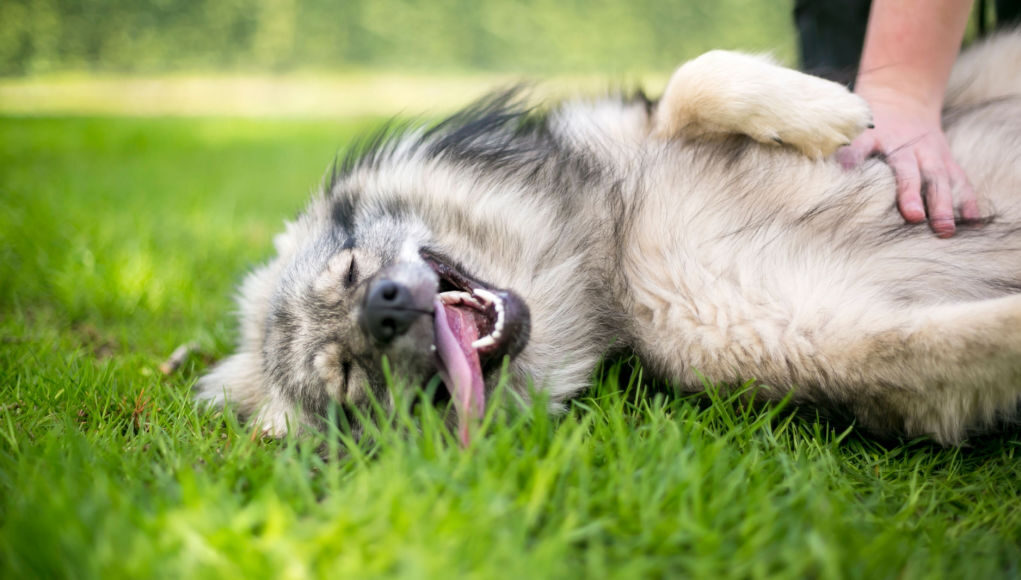Table of Contents
All pet parents are guilty of rubbing bellies when dogs turn over, right?
Of course, you can't resist that soft mushy skin of your pup! And oh, that wiggling!
But are you curious if your dog is wiggling due to a natural reflex, or are they actually ticklish?
Well, we were! So, we did a little digging. Turns out, the answer is not a simple yes or no!
Dogs do respond happily to soft finger movement on their skin. They also kick out and squirm.
But are dogs ticklish just like humans? And do they enjoy it like we do (at least, occasionally!)? Let's find out in this post!
What is Tickling in Dogs?
To start, we need to define tickling in dogs. While dogs have the same nerve endings on their skin that cause tickling in humans, their responses are different.
We have to gauge the tickling effect in dogs based on their specific behaviors.
It also means what “you” perceive a tickling reaction to be.
For instance, do you mean an uncontrollable laughter fit or an involuntary reflex when you define tickling? We'll go into a bit of detail below!
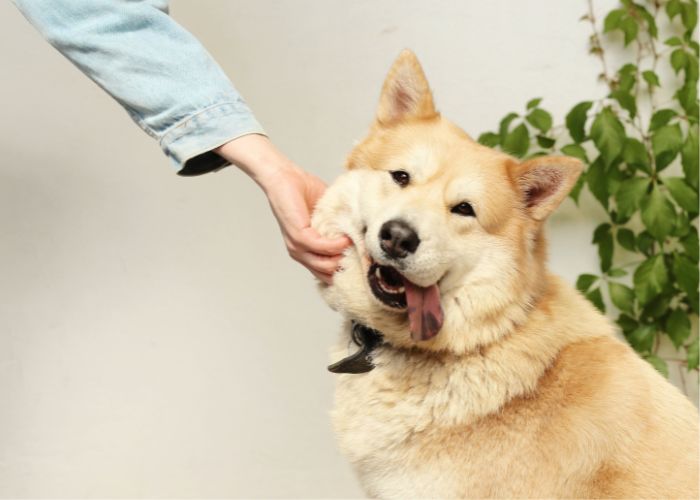
Do Dogs Laugh?
Well, yes! Dogs do laugh.
For an extended period, behavioral scientists believed that laughter was unique to human beings.
But, various studies on animal emotions revealed that animals could laugh too.
The researchers expanded this idea and found a laughing reaction in mammals and rodents.
According to Konrad Lorenz's study, dogs can laugh too. In an excerpt from his book, “Man Meets Dog,” the ethnologist explains the impression of laughing in dogs:
“Slightly opened jaws, revealing tongue, angular tilted mouth stretching from one ear to another”
He also explained that laughing in dogs is usually with “an adored owner,” and the dogs “get extremely excited that they start panting.”
Since we have established that your dog can give you laughs, we'll see whether tickling causes it!
Types of Ticklishness in Dogs
Generally, there are two types of ticklishness (yes, science has names for tickling too!)
Knismesis
Knismesis is an involuntary reaction, more like a skin sensation. It is similar to an itch or goosebumps.
It is a natural reflex of the dog that has a survival value. When a bug or fly moves on the dog's body, it gets a sensation and reacts in response to it.
Researchers believe that this sensation is quite common. And it is possible that dogs feel the same phenomenon when humans try to tickle them.
Gargalesis
Gargalesis is involuntary laughter. The dog might experience this sensation when you touch its sensitive parts.
You can trigger it by tickling the belly and the sides. You can see your dog laughing during gargalesis.
Although dogs might not experience it, some owners believe they generate this response by tickling their furry babies.
So, next time you give them a belly rub, you can observe whether your dog laughs!
Do Dogs Enjoy Tickling?
We are asking, are dogs ticklish? But the critical question is, do they like it?
We enjoy tickling our little furry babies, but are they enjoying it as much as we do? Well, most dogs do!
Still, like humans, every dog is unique. Not every dog will enjoy tickling.
So, how can you know if your dog is a fan of tickling? Look for the following signs:
- A loud pant or sigh like “aah.”
- Wagging of the tail
- Getting their tongue out
- Big smile with a show of teeth
- The thumping of the foot
- Raising the ears
- Shaking the body
- Direct eye contact (you know, when they look at you being all cute and adorable!)

Does Kicking Indicate Tickling?
Many dogs will start to kick their hind leg if they feel ticklish. It is not something out of the blue but is a natural scratch reflex!
A dog's rhythmic hind leg jerking is an involuntary response to a scratch. It simply means that the nerve endings on the skin transfer the message to the spinal cord.
As a result, the dog starts twitching movements where the nerves are triggered.
How Can I Know If My Dog Does Not Like Tickling?
Are dogs ticklish? Yes! But sadly, some dogs might not like it.
So, if you see the following signs, it can mean that your dog does not enjoy tickling. You should avoid stroking your dog when:
- Your dog shows signs of discomfort
- The dog hops back in response to tickling
- Avoids the hand and shies away
- Growls or yips as a reaction
- Shows clenched teeth
- Tucks its tail
- Pulls back its ears
- Tries to curl up like a ball
How Can I Find My Dog's Tickle Spots?
The easy answer is “trial and error”! Not every dog has the same tickle spots.
Some enjoy it on their bellies, while others might have that hidden sweet spot somewhere!
All you can do is keep exploring with your fingers! Run your fingers on the dog's body and check its reaction.
If you are tickling and your dog is just standing there, confused, then it's not it. But, If you find them visibly excited at some point, that's your cue!
The right spot will elicit an automatic happy reaction like wagging, shaking, or panting.
And hey, your dog will return for more!
Related: Do Dogs Like Music?
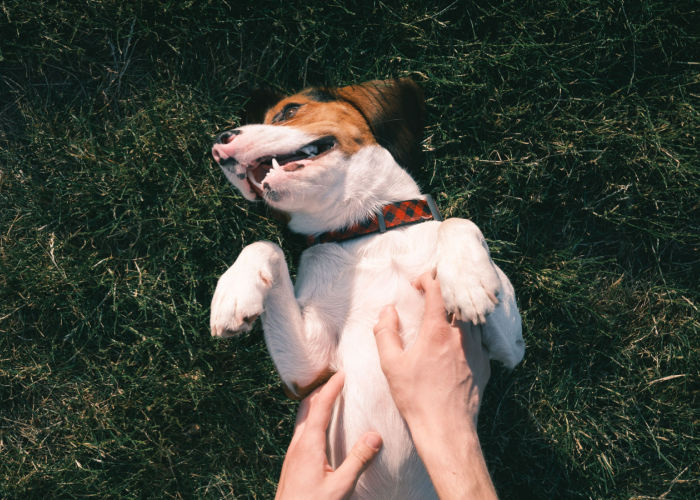
What Are the Common Tickle Spots in Dogs?
To ease your search, we have listed some of the best and most common tickle spots in dogs!
Who knows, you might get lucky with these!
So, check out the following spots on your dog's body before exploring further:
Belly
This is the best spot, hands down! But only if your dog likes it! This spot is a coin-flip situation.
Your dog either REALLY likes belly rubs or hates them! So, go ahead and give it a shot. You'll know if your dog is into it!
Behind the Ears
There is a solid reason why dogs love scratching their ears! Behind the ears is a sensitive spot on the dog's body.
Numerous nerve endings on the back of the dog's ears make it the best site for tickling. Before you test any other body part, try the ears first!
Middle of Front Legs
The area between the dog's two front legs is a nice tickling spot for most dogs. It is between the face and the belly, serving as an excellent middle ground.
The dogs usually enjoy tickling at this point because of the adjacent nerve endings from the belly.
It is also an excellent area to rub when you want to show affection.
Below the Chin
Dogs usually don't like you touching the face, but below the chin is different. Be sure that the dog trusts you and is friendly with you.
Dogs use their mouth for nearly every activity, so the jaw muscles can get sore.
Giving them a nice rub under the chin relaxes their muscles and makes them laugh.
Armpits
How can we miss armpits while talking about tickling?
Like humans, dogs can get an extreme tickling sensation in their armpits. It is the area on the dog's torso behind its front arms.
The armpit sensations are usually on either end of the spectrum. Your dog likes it, or it's a complete no-go area.
So beware when you reach for the armpits. If your dog avoids it or shows discomfort, don't touch the armpits.
The Base of the Tail
Well, this one is the last on our list because only some dogs like it. But hey, your dog might be one of them!
So, the base of the tail is another ticklish point but only at the top, not underneath the bottom.
See if your dog likes it. The dogs who like an occasional butt scratch will likely enjoy tickling in this area.
Avoid Tickling on the Paws!
While comparing the tickling sensations to the humans, remember that dog feet are different!
Humans get ticklish on their feet and may like it too. But that is not the case with dogs' paws!
The paws are sensitive regions on the dog's body. They contain a lot of nerve endings and are evolutionarily adapted to feel even subtle sensations.
Since dogs rely on their feet for mobility, they are genetically programmed to protect and guard their paws.
So, dogs can get really sensitive when you touch their paws. We recommend you avoid tickling your dog's paws as they will not like it!
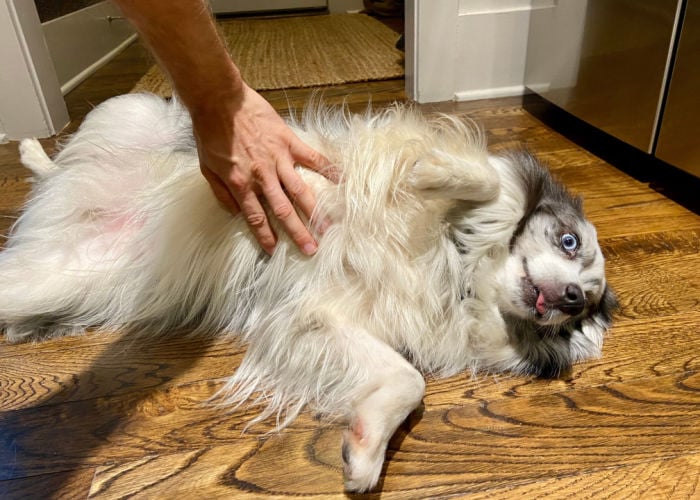
Is It Bad If I Tickle My Dog?
No! It is alright. Still, you must respect your dog’s boundaries. What do we mean by it exactly?
See, humans can easily express themselves. We are blessed with the power of communication and words. But dogs can't.
They can't tell you with words if they are enjoying something or not. All they have are bodily gestures.
So, we must observe their behaviors closely while giving them surprise tickles.
If your dog is okay and shows happiness while tickling, then they like it. And probably will ask for more.
But, if your dog avoids it, is shy, or leaves the place when you tickle, stop it. The dog is not enjoying the sensation and is indicating a refusal.
Whether your dog will enjoy tickling also depends on upbringing and adaptation.
A dog used to scratching all his puppyhood will likely enjoy the tickling sensation as an adult.
They might perceive it as a kind gesture of the owner or as a sign of affection.
On the other hand, a dog who never received belly rubs or tickling as a puppy will feel uncomfortable.
It will likely take a surprise tickle as a threat and might feel grumpy or anxious.
Medical issues can also affect the dog's reaction to the tickling. Dogs with sensitive skin usually don't like it.
The dog will also refuse tickling if it has a sore paw, abdominal pain, nasal infection, or a broken nail.
At the end of the day, we are tickling dogs to make them happy, right? So do understand when your dog is saying “no.”
Consent is essential in maintaining a solid and affectionate bond, whether humans or dogs!
Did you know? Dogs have a sense of humor too, and they show it through certain signs!
Check out our blog to read more: 10 Ways Dogs Communicate Their Sense of Humor According to Science
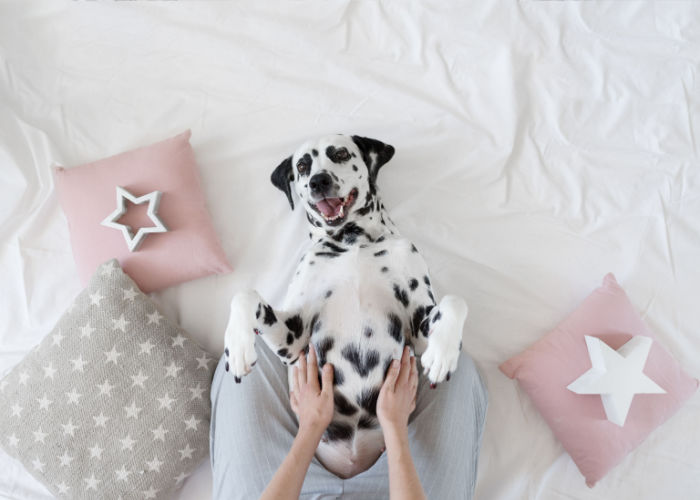
Frequently Asked Questions
Are Dogs Ticklish Like Humans?
Yes! Dogs can feel tickling like humans but cannot burst into laughter as we do. They usually show behavioral signs if they enjoy it.
Is My Puppy Enjoying Tickling?
Your puppy likes tickling if they wag their tail, start panting, smile at you, or come back for more.
My Dog Urinated a Little When I Was Tickling. Is That Okay?
It is okay if your dog passes a few drops of urine while you are tickling.
It is probably due to excitement. But make sure that they do not show signs of discomfort.
My Dog Rolls Over When I Approach To Tickle. Why Is That?
If your dog rolls over when you try to approach, he is likely showing submission.
Some dogs roll over when they are afraid, especially when they tuck in their tail.
But don't worry. Developing a strong bond with your dog can take time. Just be with him, sit slowly, and give him treats to show you are friendly and trustworthy.
Are Dog Ticklish: Final Words
Many pet parents wonder, “are dogs ticklish?” Simply put, the dogs do feel tickling sensations on their body.
But unlike humans, they don't burst into laughter. Instead, they wag their tail, pant, sigh, smile, and come to you for more!
If you're curious about your dog's tickle spots, see the common ones first!
Try ears, belly, armpit, tail, chin, and middle of front legs to check their reaction. And remember, every dog is different!
If you suspect that your dog does not like tickling, stop it and respect their boundaries!


